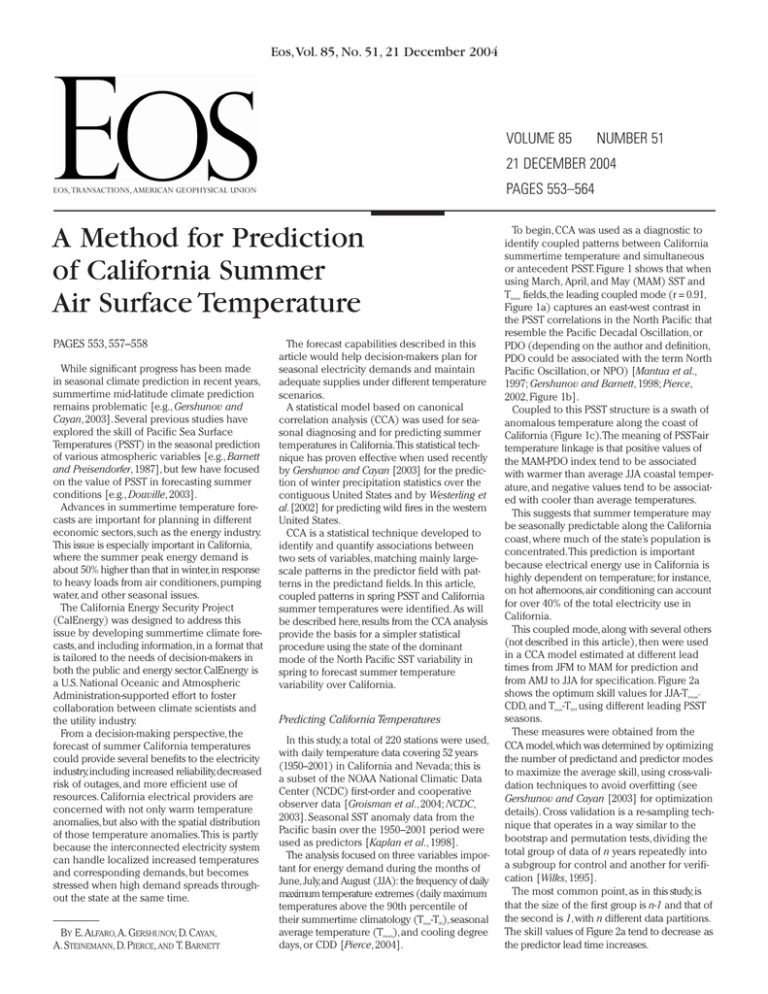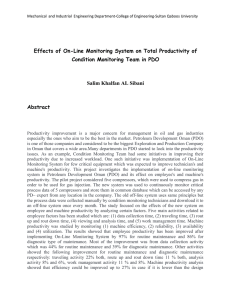Document 14007900
advertisement

Eos,Vol. 85, No. 51, 21 December 2004 VOLUME 85 NUMBER 51 21 DECEMBER 2004 EOS,TRANSACTIONS, AMERICAN GEOPHYSICAL UNION PAGES 553–564 A Method for Prediction of California Summer Air Surface Temperature To begin, CCA was used as a diagnostic to identify coupled patterns between California summertime temperature and simultaneous or antecedent PSST. Figure 1 shows that when using March, April, and May (MAM) SST and T fields,the leading coupled mode (r = 0.91, Figure 1a) captures an east-west contrast in the PSST correlations in the North Pacific that resemble the Pacific Decadal Oscillation, or PDO (depending on the author and definition, PDO could be associated with the term North Pacific Oscillation, or NPO) [Mantua et al., 1997; Gershunov and Barnett, 1998; Pierce, 2002, Figure 1b]. Coupled to this PSST structure is a swath of anomalous temperature along the coast of California (Figure 1c).The meaning of PSST-air temperature linkage is that positive values of the MAM-PDO index tend to be associated with warmer than average JJA coastal temperature, and negative values tend to be associated with cooler than average temperatures. This suggests that summer temperature may be seasonally predictable along the California coast, where much of the state’s population is concentrated.This prediction is important because electrical energy use in California is highly dependent on temperature; for instance, on hot afternoons,air conditioning can account for over 40% of the total electricity use in California. This coupled mode, along with several others (not described in this article), then were used in a CCA model estimated at different lead times from JFM to MAM for prediction and from AMJ to JJA for specification. Figure 2a shows the optimum skill values for JJA-T , CDD, and T -T , using different leading PSST seasons. These measures were obtained from the CCA model,which was determined by optimizing the number of predictand and predictor modes to maximize the average skill, using cross-validation techniques to avoid overfitting (see Gershunov and Cayan [2003] for optimization details). Cross validation is a re-sampling technique that operates in a way similar to the bootstrap and permutation tests, dividing the total group of data of n years repeatedly into a subgroup for control and another for verification [Wilks, 1995]. The most common point, as in this study, is that the size of the first group is n-1 and that of the second is 1, with n different data partitions. The skill values of Figure 2a tend to decrease as the predictor lead time increases. PAGES 553, 557–558 While significant progress has been made in seasonal climate prediction in recent years, summertime mid-latitude climate prediction remains problematic [e.g., Gershunov and Cayan, 2003]. Several previous studies have explored the skill of Pacific Sea Surface Temperatures (PSST) in the seasonal prediction of various atmospheric variables [e.g., Barnett and Preisendorfer, 1987], but few have focused on the value of PSST in forecasting summer conditions [e.g., Douville, 2003]. Advances in summertime temperature forecasts are important for planning in different economic sectors, such as the energy industry. This issue is especially important in California, where the summer peak energy demand is about 50% higher than that in winter,in response to heavy loads from air conditioners, pumping water, and other seasonal issues. The California Energy Security Project (CalEnergy) was designed to address this issue by developing summertime climate forecasts,and including information,in a format that is tailored to the needs of decision-makers in both the public and energy sector.CalEnergy is a U.S. National Oceanic and Atmospheric Administration-supported effort to foster collaboration between climate scientists and the utility industry. From a decision-making perspective, the forecast of summer California temperatures could provide several benefits to the electricity industry,including increased reliability,decreased risk of outages, and more efficient use of resources. California electrical providers are concerned with not only warm temperature anomalies, but also with the spatial distribution of those temperature anomalies.This is partly because the interconnected electricity system can handle localized increased temperatures and corresponding demands, but becomes stressed when high demand spreads throughout the state at the same time. mean The forecast capabilities described in this article would help decision-makers plan for seasonal electricity demands and maintain adequate supplies under different temperature scenarios. A statistical model based on canonical correlation analysis (CCA) was used for seasonal diagnosing and for predicting summer temperatures in California.This statistical technique has proven effective when used recently by Gershunov and Cayan [2003] for the prediction of winter precipitation statistics over the contiguous United States and by Westerling et al.[2002] for predicting wild fires in the western United States. CCA is a statistical technique developed to identify and quantify associations between two sets of variables, matching mainly largescale patterns in the predictor field with patterns in the predictand fields. In this article, coupled patterns in spring PSST and California summer temperatures were identified.As will be described here,results from the CCA analysis provide the basis for a simpler statistical procedure using the state of the dominant mode of the North Pacific SST variability in spring to forecast summer temperature variability over California. mean max Predicting California Temperatures In this study, a total of 220 stations were used, with daily temperature data covering 52 years (1950–2001) in California and Nevada; this is a subset of the NOAA National Climatic Data Center (NCDC) first-order and cooperative observer data [Groisman et al., 2004; NCDC, 2003]. Seasonal SST anomaly data from the Pacific basin over the 1950–2001 period were used as predictors [Kaplan et al., 1998]. The analysis focused on three variables important for energy demand during the months of June,July,and August (JJA): the frequency of daily maximum temperature extremes (daily maximum temperatures above the 90th percentile of their summertime climatology (T -T ),seasonal average temperature (T ), and cooling degree days, or CDD [Pierce, 2004]. max BY E.ALFARO,A. GERSHUNOV, D. CAYAN, A. STEINEMANN, D. PIERCE, AND T. BARNETT mean 90 90 Eos,Vol. 85, No. 51, 21 December 2004 Fig. 1. (a) Coupled CCA mode 1 of JJA-T (red line) related with MAM-PSST (green line); the MAM-PDO index is also plotted for comparison (blue line). Spatial patterns of predictor fields (MAM-PSST) and JJA-T are displayed in Figures 1b and 1c as correlations of the temporal evolutions with their respective variable fields at each location (i.e., grid cell for predictors and station for the predictand). Correlations are displayed in Figure 1b as contours at 0.2 intervals (negative contours are dashed, positive are solid).Absolute correlation values greater than 0.27, 0.32, and 0.39 are significant at the 0.10,0.05,and 0.01 levels,respectively. Small dots in Figure 1c represent station locations with insignificant small correlations. mean mean The SST season that produces the maximum non-overlapping predictive skill for JJA temperature season is MAM.The skill maps (Figures 2b, 2c, and 2d) illustrate the correlation between the observed value and the predicted value in a cross-validated framework. The skill of T and CDD prediction (Figures 2b and 2c) shows values greater than 0.4 (more than 20% of the variability predicted by model) in a large part of the region, while the prediction of warm extreme values provides acceptable values only for some locations in California (Figure 2d). A set of statistical models was constructed to investigate the predictability of PSST in forecasting three summer variables: cooling degree days (CDD), average temperature, and the number of maximum temperature extremes. For each of these variables, there appears to be significant model skill. Model skills are maximum for JJA PSST predicting JJA temperature measure, and decline successively with increasing PSST time lead.The model for T has greater skill than those for CDD, and CDD models have greater skill than those for T -T measure. mean mean max 90 A Simplified Statistical Model Using Spring PDO The CCA methodology as used here amounts to a sophisticated statistical model based on many coupled patterns in Pacific SST and California temperature. However, Figure 1 identifies a well-known climate pattern, the PDO, which is a dominant mode of anomalous SST variability in the extratropical North Pacific [Mantua et al., 1997], preceding coastal California summertime temperature anomalies. The PDO index is available at http://jisao. washington.edu/pdo/PDO.latest. It is therefore possible to produce a simple rule-of-thumb California coastal summertime temperature-forecasting scheme based on the Fig. 2. (a) Optimized maximum average skill for T (red line), CDD (green line), and T -T (blue line). Figures 2b, 2c, and 2d are, respectively, the T , CDD, and T -T optimized skill maps expressed as correlations between the cross-validated forecast and observations at stations using MAM-PSST as predictors.All values are displayed on the same range.Absolute correlation values greater than 0.18, 0.23 and 0.32 are significant at the 0.10, 0.05, and 0.01 levels, respectively. Small dots in Figures 2b, 2c, and 2d represent station locations with insignificant small correlations. mean max mean springtime state of the PDO.The strength of the spring PDO-summer temperature relationship suggests that it might be possible to exploit a simple contingency analysis. max 90 90 Such an analysis could be formatted to transform these predictions into a product tailored explicitly for energy producers. For this purpose the PDO index was used, and it Eos,Vol. 85, No. 51, 21 December 2004 was related to climate at stations that the California Energy Commission has defined as representative of the different California climate zones and important summertime energy demand sectors [Pierce, 2004].These stations are Blythe, Burbank-Glendale-Pasadena, Eureka, Fresno, Long Beach, Los Angeles, Sacramento, San Bernardino, San Diego, San Francisco, San Jose, and Ukiah. Figure 3 shows the conditional probabilities, in percentages, for JJA-CDD given a below and above normal MAM-PDO scenario. Figure 3 shows that under below (above) normal spring PDO conditions, the most probable scenario for summer air surface temperature is also below (above) normal in much of California, mainly in those stations along the coast. Notice also that PDO conditions during the previous winter and spring tend to persist through summer. Not only is the occurrence of below (above) normal spring PDO biased in favor of the occurrence of below (above) normal summer CDD at most of the stations, it also disfavors the occurrence of the opposite class anomalies of summer CDD. The expected value of 33% below (above) normal CDD is elevated to greater than 50% at several of the stations that were selected. The occurrence of the opposite class (above (below)) anomalies is likewise reduced to less than 20%, and in some cases less than 7%, of the sample considered.These statistical relationships are generally stronger along the coast and in the southern and central portions of the station network. References Barnett,T., and R. Preisendorfer (1987), Origins and levels of monthly and seasonal forecast skill for United States surface air temperatures determinated by canonical correlation analysis, Mon.Weather Rev., 115, 1825–1850. Douville, H. (2003),Assessing the influence of soil moisture on seasonal climate variability with AGCMs, J. Hydrometeorol., 4, 1044–1066. Gershunov,A., and T. Barnett (1998), Interdecadal modulation of ENSO teleconnections, Bull.Am. Meteorol. Soc., 79, 2715–2725. Gershunov,A., and D. Cayan (2003), Heavy daily precipitation frequency over the contiguous United States: Sources of climate variability and seasonal predictability, J. Clim., 16, 2752–2765. Groisman, P., R. Knight,T. Karl, D. Easterling, B. Sun, and J. Lawrimore (2004), Contemporary changes of the hydrological cycle over the contiguous United States: Trends derived from in situ observations, J. Hydrometeorol., 5(1), 64–85. Kaplan,A., M.A. Cane,Y. Kushnir,A. C. Clement, M. B. Blumenthal, and B. Rajagopalan (1998),Analysis of global sea surface temperatures 1856–1991, J. Geophys. Res., 103, 18,567–18,589. Fig. 3. Map of conditional JJA-CDD probabilities for a MAM-PDO scenario (a) below normal and (b) above normal.These values are expressed as percentages and are for the stations that the California Energy Commission has already defined as representative of the different California climate zones (see article).The conditional probabilities between persistent previous winterspring seasons and summer PDO are also included in the upper right. Percentage values greater (lower) than 45, 51, and 57 (24, 18, and 13) are significant at the 0.10, 0.05, and 0.01 levels, respectively for high (low) count bins in the contingency analysis. Mantua, N., S. Hare,Y. Zhang, J.Wallace, and R. Francis (1997),A Pacific interdecadal climate oscillation with impacts on salmon production, Bull.Am. Meteorol. Soc., 78, 1069–1079. National Climatic Data Center (2003), Data documentation for data set 3200 (DSI-3200): Surface land daily cooperative summary of the day, 36 pp., Asheville, N.C. Pierce, D. (2002),The role of sea surface temperatures in interactions between ENSO and the North Pacific Oscillation, J. Clim., 15, 1295–1307. Pierce, D. (2004), Effects of the North Pacific Oscillation and ENSO on seasonally averaged temperatures in California, draft manuscript, Clim. Res. Div., Scripps Inst. of Oceanogr., Univ. of Calif., San Diego. Westerling,A.,A. Gershunov, D. Cayan, and T. Barnett (2002), Long lead statistical forecasts of area burned in western U.S. wildfires by ecosystem province, Int. J.Wildland Fire, 11, 257–266. Wilks, D. S. (1995), Statistical Methods in the Atmospheric Sciences.An Introduction, 465 pp., Academic Press, San Diego, Calif. Acknowledgments This work was supported by the NOAA/ NA17RJ1231 grant funded by NOAA’s Office of Oceanic and Atmospheric Research under the California Energy Security Project and by the California Climate Change Center, sponsored by the California Energy Commission’s Public Interest Energy Research Program. Author Information Eric Alfaro,Climate Research Division,Scripps Institution of Oceanography, University of California, San Diego,and Escuela de Fisica-Centro de Investigaciones Geofisicas, Universidad de Costa Rica; Alexander Gershunov, Climate Research Division, Scripps Institution of Oceanography, University of California, San Diego; Daniel Cayan, Climate Research Division, Scripps Institution of Oceanography, University of California, San Diego, and U.S. Geological Survey, La Jolla, Calif.; Anne Steinemann,Scripps Institution of Oceanography, University of California, San Diego, and University of Washington, Seattle; and David Pierce and Tim Barnett, Climate Research Division, Scripps Institution of Oceanography,University of California, San Diego






